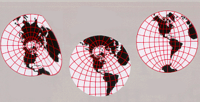Smooth manifold

Imagine you have a big and smooth surface, like a perfectly round ball or a donut. This surface looks the same no matter where you stand on it, even if you look very closely. We call this kind of surface a smooth manifold.
Now, a smooth manifold is not just any surface. It has some very special properties. For example, it has a smoothness to it. This means that if you zoom in closer and closer to any point on the surface, it will still look the same. It will be like a piece of paper that you can bend and twist, but no matter how much you do so, it will still be a smooth piece of paper.
Another special property of a smooth manifold is that it can be mapped onto another smooth manifold in such a way that these maps are also smooth. This is a bit like a puzzle, where you can take one puzzle piece and fit it perfectly onto another piece without any bumps or gaps.
Smooth manifolds are important in mathematics and physics because they can be used to describe all sorts of things, like the shapes of galaxies or the behavior of subatomic particles. They allow us to study and understand complex systems in a very beautiful and elegant way.
Now, a smooth manifold is not just any surface. It has some very special properties. For example, it has a smoothness to it. This means that if you zoom in closer and closer to any point on the surface, it will still look the same. It will be like a piece of paper that you can bend and twist, but no matter how much you do so, it will still be a smooth piece of paper.
Another special property of a smooth manifold is that it can be mapped onto another smooth manifold in such a way that these maps are also smooth. This is a bit like a puzzle, where you can take one puzzle piece and fit it perfectly onto another piece without any bumps or gaps.
Smooth manifolds are important in mathematics and physics because they can be used to describe all sorts of things, like the shapes of galaxies or the behavior of subatomic particles. They allow us to study and understand complex systems in a very beautiful and elegant way.
Related topics others have asked about:
